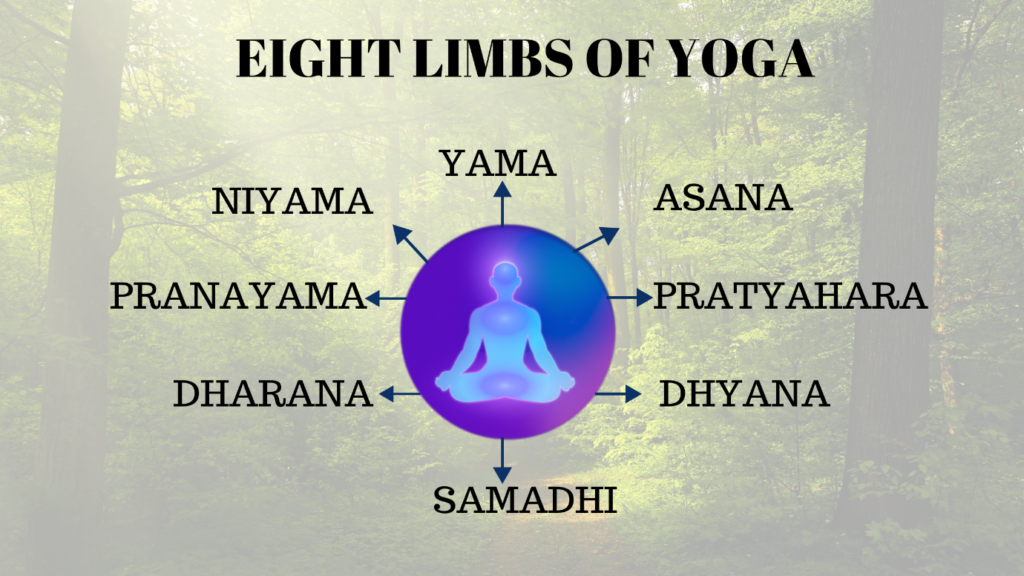
The word “Ashtanga” comes from the Sanskrit words “ashta,” meaning eight, and “anga,” meaning limb often referred to as the “eight-limbed yoga,” is renowned for its rigorous and structured series of postures (asanas), synchronized with specific breathing techniques (pranayama). The form of practice demands an intense level of physical strength, flexibility, and endurance, making it a rigorous and challenging workout for many people.
The eight limbs of Ashtanga yoga symbolise the different branches of yoga sutra philosophy that make up the Ashtanga Yoga School’s foundation.
The Eight Limbs of Ashtanga Yoga:
1. Yama (Moral Codes):
Represents the universal ethical guidelines or moral conducts that govern a yogi’s behaviour and interactions with the external world. The set of 5 yamas are:
- Ahimsa (Non-violence)
- Satya (Truthfulness)
- Asteya (Non-stealing)
- Brahmacharya (Celibacy, Self – Restraint)
- Aparigraha (Non-possessiveness)
2. Niyama (Personal Observances):
Consists of personal observances and practices that guide an individual’s conduct towards themselves. There are 5 Niyamas:
- Shoucha (Purity)
- Santosha (Contentment)
- Tapas (Self – Discipline)
- Swadhyaya (Self Examination)
- Ishvarapranidhana (Surrender to the divine)
3. Asana (Posture):
Refers to the practice of physical postures and positions designed to improve flexibility, strength, and balance. The word “asana” literally means “seat,”. In Ashtanga Yoga, asanas are practised in a specific sequence, synchronizing breath with movement to create a dynamic flow known as vinyasa. This practice not only enhances physical health by toning muscles, improving circulation, and increasing endurance but also calms the mind, reducing stress and anxiety.
4. Pranayama (Breath Control):
The term “pranayama” combines “prana” (life force) and “ayama” (control or extension), emphasizing the importance of mastering the breath to influence the flow of energy. Pranayama techniques involve various breathing exercises, such as deep breathing, breath retention, and alternate nostril breathing, each designed to increase lung capacity and enhance the flow of prana. It serves as a bridge between the physical and mental practices of yoga, preparing the mind for the higher stages of meditation and spiritual awakening.
5. Pratyahara (Withdrawal of the Senses):
Signifies the withdrawal of the senses from external objects and distractions, enabling a deeper inward focus. It involves turning the senses inward, allowing for heightened self-awareness and concentration, and setting the stage for deeper meditation and inner exploration. Pratyahara is not about denying the senses but rather gaining control over them, so they no longer dominate the mind.
6. Dharana (Concentration):
Involves focusing the mind on a single point or object. This could be a mantra, the breath, a visual object, or a specific point in the body. The practice of Dharana requires heightened attention and the ability to maintain focus, cultivating mental discipline and reducing distractions. It lays the foundation for deeper meditative practices by training the mind to remain steady and undisturbed.
7. Dhyana (Meditation):
Translates to “meditation” and is the uninterrupted flow of concentration. Unlike Dharana, where the focus is on holding concentration, Dhyana is a state of continuous and profound meditation where the mind is fully absorbed in the object of focus. This stage represents a deepening of concentration, where the practitioner experiences a heightened sense of awareness and inner peace.
8. Samadhi (Union or Enlightenment):
The eighth and final limb, is the state of complete absorption and self-realization, where the individual self merges with the universal consciousness. The ultimate goal of Ashtanga Yoga, characterized by bliss, unity, and enlightenment. This stage represents the peak of the yogic journey, where the mind is liberated from all forms of duality and the practitioner attains a state of perfect harmony.
Ashtanga Yoga offers a comprehensive and structured path to achieving physical, mental, and spiritual well-being. Through the disciplined practice of its eight limbs—yama, niyama, asana, pranayama, pratyahara, dharana, dhyana, and samadhi—practitioners can cultivate a balanced and harmonious life.
Blog By : DEEBHA SITHTA

